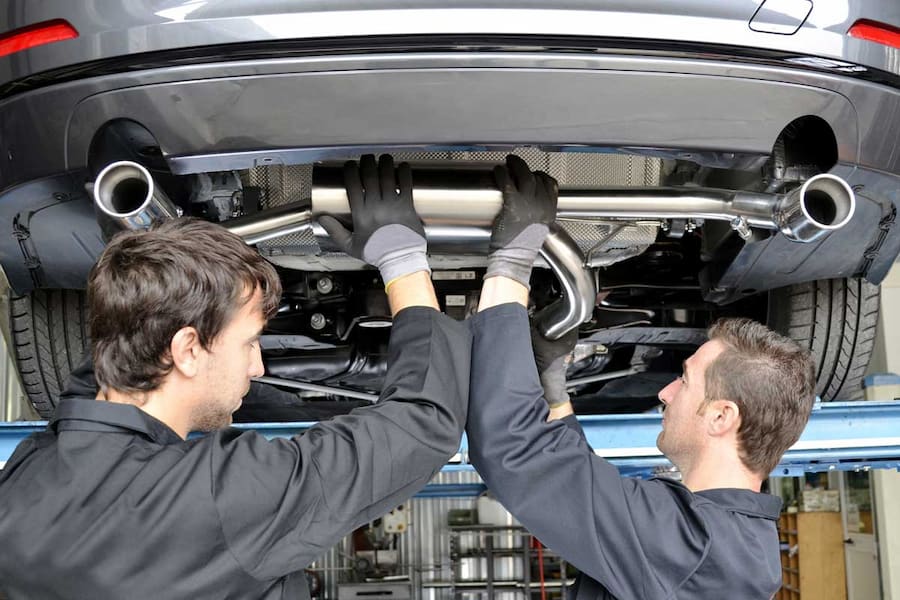Exhaust Systems – The intricate network of pipes & other components which make up your car’s exhaust system performs four vital tasks: collecting engine exhaust, filtering out toxic substances from the exhaust, lowering engine noise, & releasing the gases away from the occupants. You can recognise issues and determine when it’s time to take your vehicle to a professional by understanding how your Sport Exhaust System operates.
An Exhaust System’s Four Primary Components
Several units joined by metal tubes make up an everyday exhaust system. These components include the tailpipes, silencer, catalytic converter, & exhaust systems manifold.
1. The Exhaust Manifold.
This is where the entire system starts and is frequently referred to as the exhaust systems header. To capture the gases produced by burning petrol in the cylinders, the manifold is connected to the vehicle’s engine. The manifold is made up of several pipes which utilise flanges to seal to the engine’s exhaust systems ports.
2. A converter that uses catalysis.
The waste gases from the engine pass from the manifold to the catalytic converter via a network of pipelines. Hydrocarbons, nitrogen oxide, & carbon monoxide are among the toxic compounds found in the gases. Metals like platinum, rhodium, & palladium are stored in the catalytic converter. Up to 90% of the poisons are eliminated by a chemical process that occurs whenever the gases pass by these metals.
3. A silencer.
The silencer, an oval or cylinder-shaped chamber intended to lessen engine noise, receives the cleansed gases after passing through a pipe. Several tubes inside the silencer are made by reflecting sound waves as they go through them. Although the flow velocity of gases entering the muffler drops through the unit, backpressure may be occasionally produced by mufflers. The performance of your car may become affected by back pressure.
4. The tailpipe.
The leftover air travels down the tailpipe to the back of the car, and there it is released into the atmosphere, once the gases have been properly cleansed and the noise has been diminished.
How Do Automobile Exhaust Systems Operate?
To minimise the influence on the environment, an exhaust system controls the passage of gases from the engine to the atmosphere. Fuel and air are heated up in the engine’s combustion chamber to create energy at the start of the operation. To preserve the engine’s efficiency the exhaust systems gases produced by this combustion must be effectively eliminated.
1. Manage the noise
The exhaust gases pass through your car’s silencer, which reduces the noise of the gases escaping the car once the dangerous components have been eliminated.
2. Transport Gases
The exhaust manifold gathers exhaust gases and finally directs them out of the car.
By collecting the gases from every cylinder & expelling them via a single pipe, the exhaust manifold functions as a funnel.
3. Boost Engine Efficiency
Your car will take harder to absorb oxygen and produce more power if exhaust gases take longer to exit. Your car is going to breathe more efficiently and effectively if you have a functioning exhaust system or build a performance exhaust system. This will result in greater power & improved performance!
4. Reduce Fuel Use
In a similar vein to engine efficiency, the faster exhaust exits your car, the more fuel it uses because your engine can take in greater amounts of oxygen. An oxygen sensor is a feature of contemporary exhaust systems which detects the amount of oxygen in the exhaust. Fuel economy may then be maximised by adding more or less fuel.
The Value of a Properly Operating Exhaust System
For some reason, an exhaust system that is operating correctly is crucial. First of all, it makes sure the engine runs smoothly by controlling back pressure while successfully releasing gases. Hazardous gases might build up without this device, impairing engine efficiency and accelerating wear and tear. Second, the exhaust system is essential to protecting the environment. Emissions which lead to air pollution and global warming are less likely to be released when they are treated by a catalytic converter.
To reduce the harmful effects of automobiles, contemporary exhaust systems are made to adhere to stringent emission regulations. Finally, by lowering engine noise, the exhaust system improves the driving sensation. Excessive noise from a broken silencer or broken pipes will render driving inconvenient and possibly violate noise ordinances.
Conclusion
Modern cars are not complete without exhaust systems, which guarantee compliance with environmental standards, noise reduction, & engine efficiency. Drivers could recognise the importance that these mechanisms play in car performance and sustainability by being aware of their parts and how they work. Exhaust systems must be kept operating at their best with timely servicing, upkeep, and improvements, which will reduce environmental impact and make driving safer and more pleasurable. Maintaining the exhaust system on your automobile is essential for its efficiency & the environment, regardless of whether you drive seldom or are an avid enthusiast.
Visit Trendblogs for more informative blogs.


